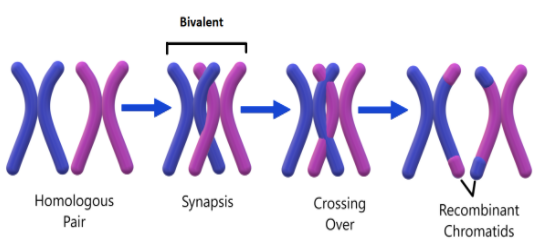
Describe the following
i) Synapsis
ii) Bivalent
iii) Charismata
Draw a diagram to illustrate your answer
Answer
503.7k+ views
Hint: i) A chiasma is the point of interaction, or physical connection, between two chromatids and homologous chromosomes.
ii) A chromosomal fusion occurs as genetic material is exchanged between both chromatids at a given chiasma, although this occurs even more often during meiosis than mitosis.
iii) They develop at sites where Spo11-generated programmed DNA breaks go through the entire recombination pathway, resulting in crossovers.
Complete answer:
Meiosis is a form of cell division that occurs in germ cells in sexually reproducing organisms to create gametes such as sperm or egg cells. It entails two rounds of division, resulting in four cells with just one copy of each chromosome (haploid). Furthermore, before separation, genetic material from the paternal and maternal copies of each chromosome is crossed over, resulting in new code variations on each chromosome. During fertilization, the haploid cells formed by meiosis from a male and female will unite to form a zygote, a cell with two copies of each chromosome.
- Synapsis: Synapsis is the pairing of homologous chromosomes. They exchange their genetic material at this point. This happens during the second stage of prophase I, also known as zygotene.
- Bivalent: A bivalent or tetrad is a pair of homologous chromosomes that have synapsed. They have formed during the zygotene stage of meiosis' prophase I.
- Chiasmata: Chiasmata is the location where two non-sister chromatids have collided. It represents the point of intersection. It is produced during the diplotene stage of meiosis' prophase I.
The figure below shows the process of synapsis, bivalent formation and crossing over.

Note:
- During the first division of meiosis, a bivalent is formed (in the pachynema stage of meiotic prophase 1).
- During the leptotene process, each replicated chromosome (composed of two equivalent sister chromatids) induces the development of DNA double-strand breaks in most species.
- Homologous recombination, which uses the homologous chromosome as a basis for reconstruction, is used to repair these breaks.
ii) A chromosomal fusion occurs as genetic material is exchanged between both chromatids at a given chiasma, although this occurs even more often during meiosis than mitosis.
iii) They develop at sites where Spo11-generated programmed DNA breaks go through the entire recombination pathway, resulting in crossovers.
Complete answer:
Meiosis is a form of cell division that occurs in germ cells in sexually reproducing organisms to create gametes such as sperm or egg cells. It entails two rounds of division, resulting in four cells with just one copy of each chromosome (haploid). Furthermore, before separation, genetic material from the paternal and maternal copies of each chromosome is crossed over, resulting in new code variations on each chromosome. During fertilization, the haploid cells formed by meiosis from a male and female will unite to form a zygote, a cell with two copies of each chromosome.
- Synapsis: Synapsis is the pairing of homologous chromosomes. They exchange their genetic material at this point. This happens during the second stage of prophase I, also known as zygotene.
- Bivalent: A bivalent or tetrad is a pair of homologous chromosomes that have synapsed. They have formed during the zygotene stage of meiosis' prophase I.
- Chiasmata: Chiasmata is the location where two non-sister chromatids have collided. It represents the point of intersection. It is produced during the diplotene stage of meiosis' prophase I.
The figure below shows the process of synapsis, bivalent formation and crossing over.

Note:
- During the first division of meiosis, a bivalent is formed (in the pachynema stage of meiotic prophase 1).
- During the leptotene process, each replicated chromosome (composed of two equivalent sister chromatids) induces the development of DNA double-strand breaks in most species.
- Homologous recombination, which uses the homologous chromosome as a basis for reconstruction, is used to repair these breaks.
Recently Updated Pages
The number of solutions in x in 02pi for which sqrt class 12 maths CBSE

Write any two methods of preparation of phenol Give class 12 chemistry CBSE

Differentiate between action potential and resting class 12 biology CBSE

Two plane mirrors arranged at right angles to each class 12 physics CBSE

Which of the following molecules is are chiral A I class 12 chemistry CBSE

Name different types of neurons and give one function class 12 biology CBSE

Trending doubts
State the principle of an ac generator and explain class 12 physics CBSE

Sketch the electric field lines in case of an electric class 12 physics CBSE

Derive an expression for electric potential at point class 12 physics CBSE

What is virtual and erect image ?

Explain the formation of energy bands in solids On class 12 physics CBSE

Draw a neat and well labeled diagram of TS of ovary class 12 biology CBSE




